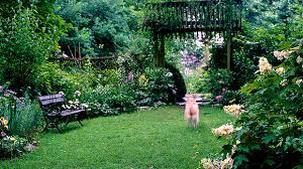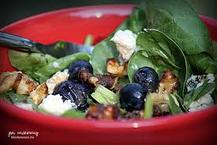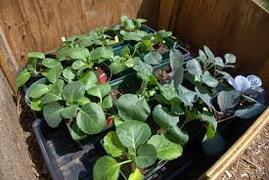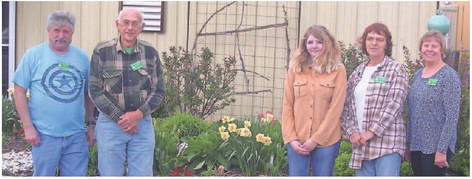|
Ozark Green Thumb BCMG Monthly e-Newsletter |
|
|
|
New Baxter County Master Gardeners Six Baxter County residents recently completed Master Gardener training offered by the University of Arkansas Division of Agriculture Cooperative Extension Service. The group participated in a 40-hour training program, and each volunteer will donate 40 hours back to the Cooperative Extension Service in the areas of horticulture and ornamental horticulture within the next year.
The group will meet monthly and work on community service projects throughout the coming year. New Master Gardeners are: (from left) Rick Gatewood, Toby Klassen, Emily Roberts, Mary White and Valerie VanZuiden. Not pictured: Ginger Turk. In 2016 the Baxter County Master Gardeners logged 4,659 volunteer hours back to the community. For more information on the Master Gardener program, call 425-2335.
0 Comments
April Garden Checklist
For more information contact Mark D. Keaton County Extension Agent Extension office at 425-2335.  This recipe is similar to one my first mother in law made for passover. It is a rich cake and great for those who cannot tolerate wheat or gluten. Ingredients:
Directions:
Preheat oven to 399 degrees F. Grease a ten inch round cake pan. Melt the bittersweet chocolate in the microwave or top half of a double boiler. Pour the chocolate into an electric mixer. Cut the butter into pieces and beat the butter into the chocolate, one piece at a time. Beat in the hot sugar water. Slowly beat in the eggs, one at a time. Pour the batter into the prepared pan. Place the pan onto a larger pan and fill the pan with boiling water halfway up the sides of the cake pan. Bake the cake in the water bath for 45 minutes. The center will still look wet. Chill cake overnight in the pan. To unmold, dip the bottom of the cake pan in hot water for ten seconds and invert onto a serving plate.  Many gardeners view shade as a challenging situation for growing plants. While some plants do not grow well in low light, numerous others thrive under these conditions. Just as moisture, temperature, and soil conditions may limit plant growth, the amount of shade present may determine which plants will grow successfully. The key is to discover which ones are adapted to the conditions in your yard or garden. Landscapes change their degree of shade over time. As trees and shrubs mature, the landscape receives greater shade. What was once a sunny garden may evolve into a shady one. Analyze the degree of shade in your garden periodically to determine if changes in plant materials may be needed due to increased shade from a maturing landscape. Several characteristics typify shade gardening. In addition to low light levels, plants growing in the shade must compete with shading trees for nutrients and water, and tolerate poor air circulation. The best way to cope with low light levels is to choose plants that do well in less light. Light shade may be described as an area that is shaded but bright. It may be completely shaded for only several hours each day. The sun's rays may be blocked by a wall or building for several hours at midday, but the area is sunny the rest of the day. Light shade may also be found in areas that receive filtered or dappled sunlight for longer periods. Edges of shady gardens or areas under the canopy of solitary, lightly branched trees are typical of filtered sunlight. During the heat of summer, light shade at midday will provide a beneficial cooling effect. Flower and foliage color may be more brilliant when plants are shielded from intense midday sunlight. Partial or medium shade is present when direct sun rays are blocked from an area for most of the day. Many established landscapes have large areas of partial shade, where sections of the yard are shaded by mature trees for much of the day but receive some direct sun early or late in the day. Bright, north-facing exposures may also be classified as medium shade. Full shade lasts all day. Little or no direct sunlight reaches the ground at any time of the day. There may be reflected light from sunnier areas of the yard or off light-colored walls. Dense shade refers to full shade under thick tree canopies or in dense groves of trees. Areas under stairways, decks or covered patios on the north side of the house receive full shade. Keep in mind that light patterns change with the seasons. An area that is in full sun in summer when the sun is high in the sky may have medium shade in spring and fall, when the sun is at a lower angle. Study your garden through the seasons to accurately determine what type of shade is present. Available sunlight may be increased by selective pruning. Removal of lower limbs on large trees may increase light levels significantly. Large shade trees are a valuable resource that in most cases should be preserved. However, removal of diseased, unattractive, or poorly placed trees improves the beauty of your property and increases the light available for plant growth. Take advantage of reflected light, if possible. White or light-colored surfaces reflect more light than dark-colored ones. Light-colored house siding or fences may increase available light to plants. Plants growing in the shade often must also compete with roots of shading trees for nutrients and moisture. Shallow rooted trees such as maples and willows are particularly troublesome. Adding organic matter to shade garden soils will help. Most woodland species are accustomed to growing in soils rich in leaf litter compost. Raking and removal of leaves each fall in the typical landscape disrupts this natural nutrient recycling process. If leaves are not removed, they can mat down and smother shade garden plants, but shredded leaves can be safely applied as a mulch. Another option is to compost the leaves first, and apply the compost in core aeration holes or in small pockets dug into the garden. Do not haul in several inches of compost-rich amendment to till into soil under shade trees. Some species, such as oaks, are extremely sensitive to changes in soil depth within their root zone. In addition, tillage will damage many of the tree's roots, starting a decline from which the tree may never recover. If the gardener is patient, earthworms will eventually incorporate surface-applied organic matter. Organic matter loosens heavy clay soils, improving drainage. In sandy soils, organic matter will increase the water-holding capacity. As organic matter breaks down, it also releases nutrients to the plants. Roots competing for limited surface water may cause shade gardens to dry out more quickly than sunny sites during extended dry periods. Some shade-tolerant plants are adapted to low moisture situations, while others require moist shade. Provide water according to the plants' needs. Branches or walls that cast shade also block air movement. Poor air circulation coupled with lower light levels means foliage of plants stays wet longer in the shade than in sunny areas. Most plant disease problems are worse under these conditions. Prevent disease problems by selecting disease-resistant varieties when available. Space plants farther apart in the shade to allow more air movement around each individual plant. Water with soaker hoses or drip irrigation systems to avoid wetting the foliage. Removal of lower tree limbs may funnel breezes underneath the tree canopy, thereby improving air circulation. Bright, bold colors are less common in shade tolerant plants than in sun-loving ones. Flowers are usually produced less abundantly in the shade as well. For these reasons, shade gardens are often more subtle and restful than sunny ones. Plant textures, forms, and slight color differences become more important elements of the design. Texture has many aspects. Large-leaved plants such as hostas have a coarse texture, while finely divided fern fronds create a fine texture. Strong contrasts in texture accentuate their differences. Use strong textural contrasts only where emphasis is needed. Pyramidal or upright, columnar plant forms serve best as accents in the shade. Rounded, weeping, or spreading forms create a more spacious effect and can be used more liberally in the design. Glossy leaves have more impact than dull or velvety ones. Variegated or yellow-green foliage is evident in the shade more than solid green or blue-green foliage. Light colors — white, cream, yellow and pastel pink — stand out in the shade. Deep reds, blues and purples may fade into the shade unless set off by a contrasting lighter color. To emphasize plantings in the shade, concentrate on plants with light-colored flowers or foliage. Almost all food crops grow best in sunny locations. Not only do they need full sunlight for good growth, few tolerate root competition from trees. Cool-season salad vegetables such as lettuce, spinach and radishes may benefit from light shading through the heat of the summer. Beans, beets, broccoli, cabbage, kohlrabi, peas, potatoes, rhubarb and turnips will grow in light shade but not produce as large a crop as plants growing in full sun. Currants and gooseberries are fruits which tolerate medium shade and still produce a crop. Bramble fruits such as blackberries and raspberries grow in light shade, but yields will be reduced. Source: Christoper J. Starbuck
Department of Horticulture University of Missouri Extension  A quick and easy salad to take advantage of fresh produce. Ingredients:
Directions:
In a jar with a tight-fitting lid, combine the first five ingredients and shake well. In a large salad bowl, toss the spinach, blue cheese, blueberries and pecans. Add dressing and toss gently. Yield: 6 to 8 servings.  Whether you've been babying seedlings along under grow lights or overwintering a few tender perennials you couldn't let go of last fall, it's time to start getting them outside. But you can't just chuck them out there as soon as the ground begins to thaw. Plants that have been indoors need to be acclimated to the fluctuating temperatures, wind and sunlight. In other words you need to harden them off. It's a simple process of gradually increasing the amount of time they're outside, usually by taking flats or pots in and out of the house. As plants spend more time outside, stems get stronger and their leaves develop a thicker cuticle, the waxy covering on the surface of a leaf that prevents water loss. this helps them tolerate more varied weather conditions. WHEN TO GET STARTED First decide when you want to put your plants in the garden and back up a couple weeks from there to know when to start hardening off. Tender plants' planting date will be determined by your likely last frost date. If you don't know when your last frost date is check with your local county extension agency. Cool weather types such as pansies tolerate temperatures in the 40-degree F range so you can plant a month before your likely last frost date. House plants, tropicals and warm season vegetables, such as tomatoes, prefer days at 70 degrees F (or warmer) and nights in the 50's. Seedlings should have at least four to six sets of true leaves before going out. WHERE TO PUT PLANTS Start plants in a protected spot out of direct sunlight and strong wind for an hour or two in mid-afternoon to avoid shock. Examples include under a tree, next to a hedge and near the wall of the house or garage. Bring plants inside for the night. Each day increase the time spent outside by 35 to 40 minutes. If there are a few days of bad weather-driving rain or an unexpected cold snap- leave them inside. Once plants are used to being outdoors all days (and mild overnight weather is forecast), pull them into a protected spot out doors for the night, too. Full sun plants will need time to get used to direct sunlight. Start them out in part to full shade on the north side of your house or under a tree. Every couple of days edge them into a bit more light until they are basking in full sun. once plants stay outdoors day or night for three or four days in a row, they're ready to go in the ground. Excerpt from Garden Gate Magazine
 Verbenas are long blooming annual or perennial flowers that possess the virtues of heat tolerance and an extremely long bloom season. Many perennial verbenas are relatively short lived, but their vigor and heavy flowering make up for this defect. They do well grown as annual flowering plants also, since they bloom quickly during the first season after planting. Height/Spread
Verbenas vary considerably in size. The ground skimming moss verbena and trailing verbena reach 1 foot or less in height and spread from 2 to 5 feet wide. Verbena rigida usually grows 1 to 1½ feet tall, while purpletop vervain and the native blue verbena can reach 4 to 5 feet tall, but only a foot or two in width. Growth Rate Verbenas generally grow moderately to quickly, and unlike many perennials, bloom well the first season after planting. Some varieties, such as 'Homestead Purple', are extremely vigorous. If plants outgrow their assigned space, they tolerate trimming back well. Ornamental Features Verbenas are mainly grown for their remarkable length of bloom with most blooming from spring until close to frost if trimmed back once or twice in mid summer. Flower color ranges from white through pink, red, lavender, blue and purple. Landscape Use Verbenas require a location that receives full sun throughout the day. They must have well-drained soil. They will not tolerate overcrowding with poor air circulation, shade or soil that stays overly moist. Most problems of verbenas occur in improper growing conditions. Verbenas are best planted in the spring or summer. Pinch the tips of the branches at planting time to encourage dense branching and a fuller plant. Newly planted verbenas will need to be kept moist for the first few weeks until the roots have spread into the surrounding soil. While established verbenas are drought tolerant, performance, bloom, and growth rate will be reduced if they are too dry for a long period. During their blooming period, give them a thorough watering once a week if they do not receive an inch of rain that week. Avoid overhead watering. If bloom slows during the summer, trim the whole plant back by about one fourth of its height and spread, water thoroughly and fertilize lightly. The plant will return to bloom within 2 to 3 weeks. A light application of a complete fertilizer such as 16-4-8 in mid- to late spring and again after trimming back will revitalize plants, but additional fertilization is not generally required. Plants growing in very sandy, poor soil may need more frequent fertilization. In the fall you can trim back verbenas lightly to give a neater appearance to the garden, but do not cut severely until spring as new growth begins to appear. Overly severe fall pruning can reduce cold hardiness and plants may not survive a cold winter. Most verbenas are short-lived, so you should plan on replacing them after two or three years. However, some species can re-seed and naturalize in the garden. Verbenas, especially the trailing and moss types, grow very well in containers. Fertilize container grown plants either with a controlled-release fertilizer, or with a liquid fertilizer once a month. Container grown plants should be watered more frequently, and not allowed to dry out. All verbena will attract numerous butterfly species, bumblebees, and hummingbirds. Problems Verbenas can suffer from a variety of problems, but most occur when they are grown in low light, poorly drained soil, or when the soil stays excessively moist from excessive watering. Poor air circulation from over crowded conditions can also lead to disease problems.
Verbenas are relatively pest free
Cultivars & Species Tall growing Purpletop vervain (Verbena bonariensis)
Trailing Verbena (Glandularia canadensis; formerly Verbena canadensis) Trailing verbena is a native perennial throughout South Carolina. The plants have a low spreading form and will flower profusely all summer. Creeping stems often root into the soil or mulch. Plants are tolerant of heat and drought, although best growth will occur with plenty of water and fertilizer. Like most verbenas, they need excellent soil drainage. There are numerous cultivars available. Many are trailing verbenas are hybrids of G. canadensis with other species.
Rigid Verbena (Verbena rigida) This South American verbena forms spreading patches of brilliant purple. It is widely naturalized along roadsides throughout South Carolina. It spreads by long white rhizomes (underground stems) which spread out in all directions and form dense colonies. Because of this growth habit, it forms a very effective ground cover. Rigid Verbena is hardy and drought resistant.
(Glandularia pulchella; formerly Verbena tenuisecta) Native to South America, but naturalized throughout the southern United States, moss verbena is so well adapted as to be commonly believed to be native. It is generally hardy in the lower parts of South Carolina, and often survives mild winters in the Upstate. Moss verbena has finely cut leaves and a very low growing habit, explaining its common name. Many of the cultivars are hybrids with other species.
(Glandularia x hybrida; formerly Verbena x hybrida) Annual verbena is a relatively common garden bedding plant. Most varieties will decline once summer heat increases. Perennial type verbenas will perform better in South Carolina, and will bloom quickly the first season of planting. Source: Clemson University Cooperative University |
Archives
April 2022
|
|

